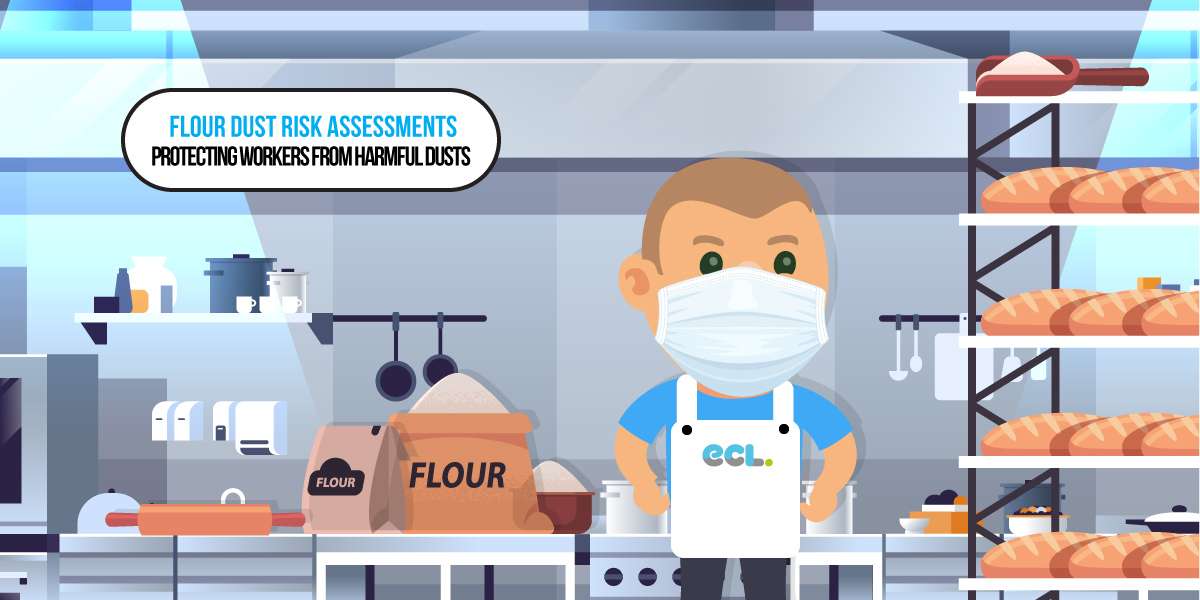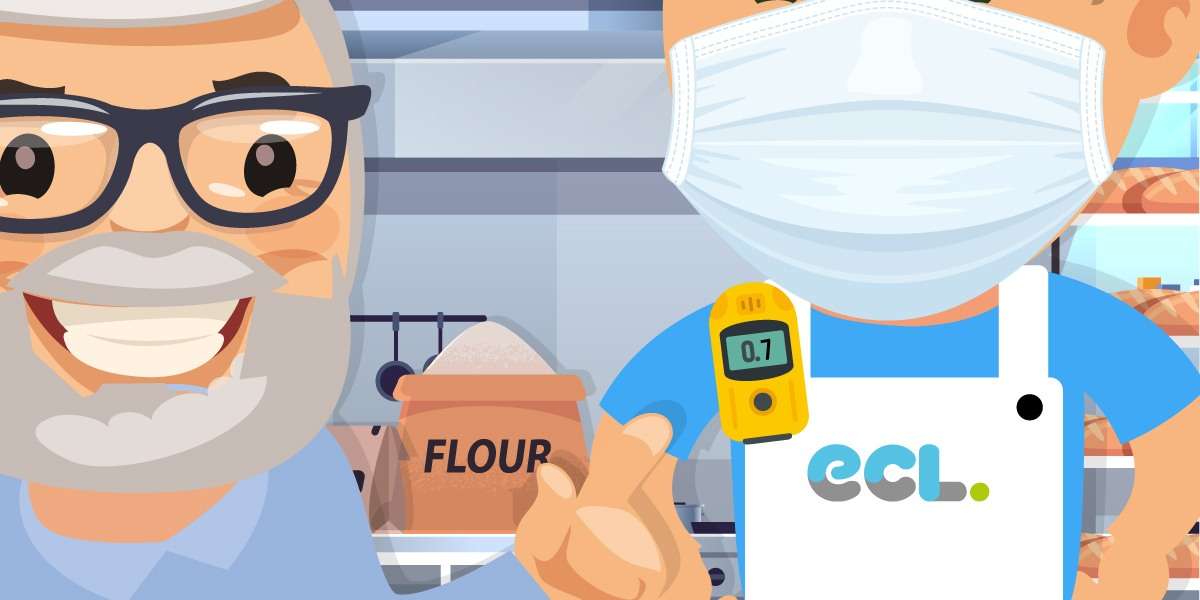Flour Dust Risk Assessments are important for many industries, especially industries that involve flour dust exposure due to the handling, processing, or production of flour and flour-based products.
Flour dust has been assigned a ‘SEN’ notation within the EH40/2005 Fourth Edition 2020, indicating it is a respiratory sensitiser and should be controlled as low as reasonably practicable (ALARP).
Health and safety regulations require employers to carry out Risk Assessments to outline the risks to health from COSHH food hazardous substances present in the workplace. A sufficient and suitable Flour Dust Risk Assessment is required wherever exposure to flour dust is likely to occur.

Who Requires A Flour Dust Risk Assessment?
Understanding which employees could be exposed to flour dust is very important when conducting a Flour Dust Risk Assessment. All potential sources of exposure should be identified as well as who is likely to be exposed, and how long for.
Approximately 100,000 people working in the UK Baking Industry encounter flour dust exposure on a daily basis. Some of the industries that require the flour dust assessments include:
- Bakery and Confectionery: Bakeries and confectioneries, including large industrial bakeries and small artisanal bakeries, can generate high levels of flour dust during the production and processing of baked goods when sieving, weighing, and mixing.
- Flour Mills: Flour mills generate elevated levels of flour and Grain Dust during the milling and processing of grain into flour.
- Food Manufacturing: Some food manufacturing facilities, such as pasta, pizza, pastry, and biscuit factories, use flour as a key ingredient and can generate significant amounts of flour dust during production.
- Agriculture: Agricultural workers, including those who work in grain storage and handling facilities, can be exposed to flour dust during the handling of grain and flour.
- Packaging Plants: Loading, disposing or dry sweeping of flour dust from machinery, shelving units or the floor can cause exposure.
It is important for employers in the above industries to assess the risks of flour dust exposure and implement appropriate control measures to protect the health of workers.
Regular Workplace Air Monitoring can help ensure that flour dust exposure levels remain below the Workplace Exposure Limits (WEL) and that workers remain safe and healthy.
What Is Flour Dust?
Flour dust is finely ground organic particles of cereal or pulses like wheat, rye, sorghum, barley, oats, rice, or corn processed by milling and grinding, with exposure arising from the subsequent handling and use.
Flour dust includes all additives which are used once they have been added to create the final product.
Most particles within dust clouds from organic material such as flour are mainly within the inhalable fraction, with a minor proportion of respirable particles.
What Are The Risks And Why Are Flour Dust Risk Assessments Important?
Flour dust often contains proteins, enzymes, and other substances that can cause potential health problems if inhaled.
The two most significant dangers include the inhalation and combustion of flour dust.
The most significant health risk associated with flour dust is the development of baker’s asthma or baker’s lung, which are respiratory conditions that can cause coughing, wheezing, shortness of breath, and other symptoms.
Businesses should also be aware of the risk of explosions caused by flour dusts. Like any other organic matter, flour is combustible if ground finely enough.
If the dust is in a confined area and the concentration is fine enough, a simple spark could cause a large explosion. The risk can be assessed by a trained Fire Risk professional who can complete a DSEAR Assessment and/or Fire Risk Assessment.

What Are The Hazards Of Flour Dust Exposure?
Bakers Asthma and Bakers Lung are types of occupational asthma and hypersensitivity pneumonitis that are caused by the continued exposure and inhalation of flour dust.
Frequent low-level exposure may not create symptoms for up to 30 years but can still cause long-term health issues.
They can cause symptoms such as:
- Wheezing
- Coughing
- Shortness of breath
- Chest tightness and pain
- Difficulty breathing.
If an individual becomes sensitised to flour dust, exposure to low levels of flour dust could trigger an asthmatic attack; possibly resulting in the worker needing to change profession.
In severe cases, flour dust exposure can lead to lung fibrosis and permanent lung damage. Some flours may contain other chemicals such as; flavourings, colouring or artificial sweeteners which can further irritate a workers respiratory tract.
What Are The Workplace Exposure Limits For Flour Dust?
The Workplace Exposure Limits (WELs) for flour dust in the United Kingdom are set by the Health and Safety Executive (HSE) as part of the Control of Substances Hazardous to Health Regulations (COSHH).
The WELs comprise of a long-term exposure limit of 10mg.m-3 (based on an 8-hour time-weighted average) and a short-term exposure limit of 30mg.m-3 (averaged over 15 minutes) for the inhalable fraction.
However, as flour dust is a respiratory sensitiser, exposure should be reduced as low as reasonably practicable (ALARP). By following good control practices, the HSE considers that exposures below 2mg.m-3 (averaged over 8 hours) should be achievable.
What Are The Control Measures And How To Prevent Flour Dust Exposure?
All UK employers have a legal obligation to prevent and reduce exposure of their employees to flour dust ALARP.
To prevent such exposure, it is important to implement effective control measures. These can be achieved following the hierarchy of control and the below engineering control measures:
- Investigate the use of low dust Wheat flours to reduce airborne dust or find ways that a process can generate less flour dust.
- Use non-stick surfaces where possible to stop dough sticking.
- Ensure effective and appropriate local exhaust ventilation (LEV) is available, is used and is within date of its LEV Thorough Examination and Testing (see COSHH Regulation 9 and HSE guidance document HSG258)
- Handle flour with care, reduce the distance flour is dropped from and use a scoop to move flour. Tipping bags into mixers should be completed at a low height and carried out with care. Empty bags should be disposed of carefully as this could generate a second source of exposure.
- Avoid damage to bags and spillages wherever possible. Use a vacuum with a HEPA (High Efficiency Particulate Air) filter and wet cleaning methods if spillages do occur.
- Use dredgers or sprinklers to spread dusting flour rather than hand throwing.
- Minimise the generation of airborne flour dust by starting mixers on a slower speed.
- Develop a written exposure control plan for the flour dust.
- Personal protective equipment (PPE), such as respirators, should also be used to protect workers from inhaling flour dust (only if other control measures are not effectively controlling exposure).
- Training workers on the dangers associated with flour dust, how to report ill health symptoms and the correct use of any controls in place.
In addition to the above controls, low-dust flour products could potentially be used. Some contain additional oils to reduce the dustiness with some being processed through a hydro-thermal refiner that can remove finer flour particles.
These can be used to significantly reduce the dust produced whilst carrying out the sieving and tipping process. These reductions in dust can also lead to less time spent cleaning and the potential of less flour being wasted.

How to Assess the Risks of Flour Dust?
To assess the risks associated with flour dust, it is important to understand the level of exposure and the type of dust that workers are exposed to:
- Are all flour dust exposure control measures in place and being used correctly by all workers?
- Complete a Dust Lamp Survey to visualise airborne levels and potential dust sources.
- Monitor personal exposure though Air Sampling and Monitoring completed by a professional and competent occupational hygienist, results of which can be directly compared to the flour dust WEL. Under COSHH regulations employers have a legal requirement to control the risk of exposure to substances that may cause ill health.
- Implement relevant health surveillance including pre-employment screening, questionnaires during employment completed at 6 weeks and 12 weeks after start date and then on an annual basis (as a minimum). Results should be analysed by a professional occupational health worker who can advise on further action if needed including lung function tests.
- Undertake routine Thorough Examination and Testing of LEV systems installed for the purpose of exposure reduction and control
It is also important to consider any pre-existing conditions that may make workers more susceptible to the effects of flour dust.
How ECL Can Help with Flour Dust Risk Assessments?
ECL is a leading provider of Occupational Hygiene and Health and Safety Services in the United Kingdom with over 20+ years’ experience.
The HSE specifies the method of monitoring workplace air for flour dust in document MDHS14 (Methods for the Determination of Hazardous Substances).
Our consultants position the sampling head containing a pre-weighed filter within 300mm of the breathing zone of the operator. These will then be sent to our laboratories for analysis of the filters.
Our team of experienced and professional occupational hygiene specialists will help you to assess the risks associated with flour dust, provide practical advice which can help implement effective control measures and protect your workers from the harmful effects of hazardous dusts and chemicals.
These methods can help improve morale and productivity due to lower sickness rates. Lead to less civil claims and potentially reduce PPE and other associated costs.
All our consultants are members of the British Occupational Hygiene Society (BOHS) and can help with Flour Dust Risk Assessments, Noise Surveys, and various other Personal and Workplace Air Monitoring.

